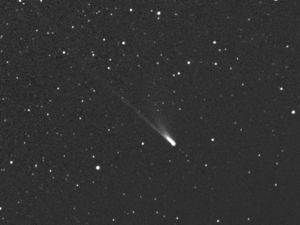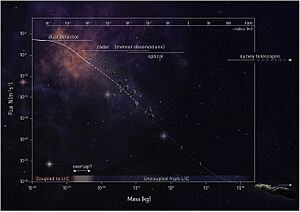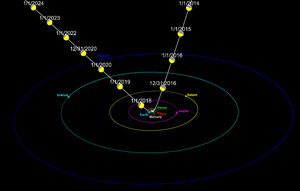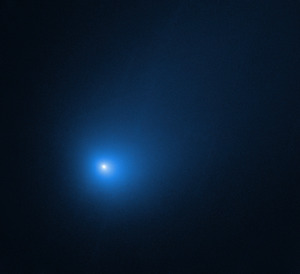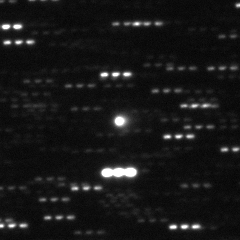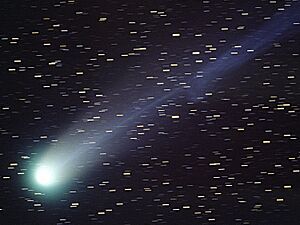Interstellar object facts for kids
An interstellar object is a space object that travels through the vast empty space between stars. These objects are not held in orbit by any star's gravity. They can be things like asteroids, comets, or even rogue planets (planets that don't orbit a star).
Sometimes, an object might be on an interstellar journey but passes close to a star for a short time. When this happens, it might be called an interstellar interloper.
The first interstellar objects found were rogue planets. These are planets that were kicked out of their original star systems. It's tricky to tell them apart from other planet-sized objects that form in space, similar to how stars form.
The very first interstellar object seen traveling through our own Solar System was 1I/ʻOumuamua in 2017. These objects move very fast, showing they didn't come from our Solar System. Interstellar objects were once orbiting a star but then broke free. Different things can cause planets and smaller objects to escape their home stars.
Contents
Naming Interstellar Objects
When the first interstellar object was found in our Solar System, a new way to name them was created. They are now given "I numbers," similar to how comets are numbered. The Minor Planet Center is in charge of giving out these numbers. For example, ʻOumuamua was the first, so it's called 1I/ʻOumuamua.
How Many Interstellar Objects Are There?
| Object | Speed |
|---|---|
| C/2012 S1 (ISON) (a comet from our Oort Cloud) |
0.2 km/s 0.04 au/yr |
| Voyager 1 (for comparison) |
16.9 km/s 3.57 au/yr |
| 1I/2017 U1 (ʻOumuamua) | 26.33 km/s 5.55 au/yr |
| 2I/Borisov | 32.3 km/s 6.81 au/yr |
| 3I/2025 N1 (ATLAS) | 58.0 km/s 12.24 au/yr |
Scientists believe that several interstellar objects, like ʻOumuamua, pass inside Earth's orbit every year. They also think that about 10,000 of these objects are passing inside Neptune's orbit on any given day.
Interstellar comets sometimes travel through the inner Solar System. They usually come from the direction of the constellation Hercules. This is because our Solar System is moving towards that direction. Before ʻOumuamua was found, scientists used to guess how many comets were in interstellar space. Now, with ʻOumuamua's discovery, they estimate there are about 10,000 similar objects, around 100 meters (328 feet) in size, inside Neptune's orbit at any time. Each of these stays for about 10 years.
Models of how the Oort cloud formed suggest that many more comets are thrown out into interstellar space than stay in the Oort Cloud. Some studies say 90% to 99% of comets are ejected. It's likely that comets formed in other star systems are also scattered in the same way. Some scientists think our Oort Cloud might even have formed from objects ejected from other stars in the Sun's birth cluster.
Objects orbiting a star can be kicked out if they interact with a third large body. This makes them interstellar objects. For example, in the 1980s, C/1980 E1 was orbiting the Sun. It passed close to Jupiter and was sped up enough to escape the Solar System. It is now heading for interstellar space.
It's hard to spot an interstellar object unless it passes through our Solar System. When it does, we can tell it's interstellar because it follows a very specific path called a hyperbolic trajectory. This means it's not held by the Sun's gravity. Objects that are held by the Sun's gravity follow elliptic orbits.
Sometimes, an interstellar comet might get caught by the Sun's gravity and start orbiting it. Computer models show that Jupiter is the only planet big enough to capture one. This might happen about once every 60 million years. Comets Machholz 1 and Hyakutake C/1996 B2 might be examples of such captured comets. They have unusual chemical makeups compared to other comets in our Solar System.
Recent studies suggest that asteroid 514107 Kaʻepaokaʻawela might be a former interstellar object. It may have been captured about 4.5 billion years ago. Also, comet C/2018 V1 (Machholz–Fujikawa–Iwamoto) has a good chance (72.6%) of coming from outside our Solar System. Scientists from Harvard believe that material, and even tiny spores, can travel vast distances between star systems. The discovery of ʻOumuamua confirms that objects can indeed travel between different star systems.
Interstellar objects visiting our Solar System come in all sizes. They range from objects kilometers (miles) wide down to tiny dust particles. Interstellar dust and meteoroids carry important information from their parent star systems. However, finding these objects across all sizes is not easy. Very small interstellar dust particles are pushed out of the Solar System by electromagnetic forces. The largest ones are too spread out to study well with spacecraft. It's also hard to tell the difference between interstellar and Solar System objects for medium sizes (0.1–1 micrometer).
Large interstellar visitors like asteroids and comets were first found in our Solar System in 2017 (1I/ʻOumuamua) and 2019 (2I/Borisov). Scientists expect to find more of them with new telescopes, like the Vera Rubin Observatory.
In May 2023, astronomers reported that other interstellar objects might have been captured into orbits near Earth over the years.
Confirmed Interstellar Objects
1I/2017 U1 (ʻOumuamua)
A faint object was spotted on October 19, 2017, by the Pan-STARRS telescope. Observations showed it was following a very fast, hyperbolic path around the Sun. This meant it was not held by the Sun's gravity and was likely an interstellar object. It was first thought to be a comet, but no cometary activity (like a tail) was seen. So, it was renamed. After its interstellar nature was confirmed, it was named 1I/ʻOumuamua. The "1" means it's the first such object found, "I" stands for interstellar, and "ʻOumuamua" is a Hawaiian word meaning "a messenger from afar arriving first."
ʻOumuamua did not show any cometary activity. This suggests it might have come from the inner parts of its home star system, losing all its icy materials. It could be like the rocky asteroids or dead comets we have in our Solar System. Another idea is that ʻOumuamua lost its icy materials over billions of years of being exposed to space radiation, forming a thick crust after it was kicked out of its parent system.
ʻOumuamua had a very high eccentricity of 1.199. This was the highest ever seen for a natural object in our Solar System until comet 2I/Borisov was found in August 2019. In July 2025, 3I/ATLAS was discovered with an even higher eccentricity of 6.1.
In September 2018, astronomers suggested several possible home star systems from which ʻOumuamua might have started its journey.
2I/Borisov
This object was found on August 30, 2019, by Gennadiy Borisov in Crimea. On September 13, 2019, a large telescope called the Gran Telescopio Canarias looked at 2I/Borisov. It found that the object's surface was similar to typical comets from our own Oort Cloud. The IAU (International Astronomical Union) kept the name Borisov and gave it the interstellar name 2I/Borisov. On March 12, 2020, astronomers reported that Borisov's nucleus (its solid core) was breaking apart.
3I/ATLAS
A third interstellar object was discovered by ATLAS on July 1, 2025. It was about 4.5 AU (about 675 million kilometers or 420 million miles) from the Sun. It has a record-breaking eccentricity of 6.15. The object will come closest to the Sun on October 29, 2025. Both when it came in and when it leaves, the object has an interstellar speed of about 58 kilometers per second (36 miles per second).
Possible Interstellar Objects
In 2007, scientists reported that a multi-centimeter (several inches) intergalactic meteor likely hit Earth's atmosphere over Russia on July 28, 2006.
In November 2018, Harvard astronomers Amir Siraj and Avi Loeb suggested there could be hundreds of ʻOumuamua-sized interstellar objects in our Solar System. They based this on how these objects orbit. They also pointed out some centaur objects, like 2017 SV13 and 2018 TL6, that might have been captured long ago. These objects are currently orbiting the Sun.
In May 2023, astronomers reported that other interstellar objects might have been captured into orbits near Earth over the years. However, NASA and other experts have expressed doubts about these claims.
2014 Interstellar Meteor
CNEOS 2014-01-08 (also called Interstellar meteor 1; IM1) was a meteor that weighed about 0.46 tons (about 1,000 pounds) and was about 0.45 meters (1.5 feet) wide. It burned up in Earth's atmosphere on January 8, 2014. In 2019, some scientists suggested this meteor came from interstellar space. It was moving at about 60 kilometers per second (37 miles per second) and exploded near Papua New Guinea. In April 2022, the U.S. Space Command confirmed the meteor's high speed. In 2023, The Galileo Project went on an expedition to try and find small pieces of this unusual meteor. However, other scientists have questioned their findings.
Some astronomers doubt the interstellar origin of this meteor. They say that the data used doesn't include how accurate the speed measurements are. It's hard to be sure about single data points, especially for smaller meteors. In November 2022, a paper suggested that the meteor's unusual properties might be due to measurement errors, not because it was truly interstellar. Finding any pieces of the meteor is also very unlikely.
2017 Interstellar Meteor
CNEOS 2017-03-09 (also called Interstellar meteor 2; IM2) was a meteor weighing about 6.3 tons (about 14,000 pounds). It burned up in Earth's atmosphere on March 9, 2017. Like IM1, it was very strong. In September 2022, astronomers Amir Siraj and Avi Loeb reported that this meteor was a candidate for an interstellar object. They based this partly on its high material strength.
Future Missions to Interstellar Objects
It's very hard to send spacecraft to visit interstellar objects because they move so fast. But it's not impossible.
The Initiative for Interstellar Studies (i4is) started "Project Lyra" in 2017. This project looks at how possible it would be to send a spacecraft to 1I/ʻOumuamua. They suggested several ways to send a spacecraft to ʻOumuamua within 5 to 25 years. One idea involves using Jupiter's gravity to speed up the spacecraft, then flying very close to the Sun to get even more speed.
The Comet Interceptor spacecraft, from ESA and JAXA, is planned to launch in 2029. It will wait at a special point in space (the Sun-Earth L2 point) for a suitable long-period comet to intercept and study. If no good comet is found during its 3-year wait, the spacecraft could be sent to intercept an interstellar object if one is reachable.
See also
 In Spanish: Objeto interestelar para niños
In Spanish: Objeto interestelar para niños
- Hyperbolic asteroid
- List of artificial objects leaving the Solar System
- List of hyperbolic comets


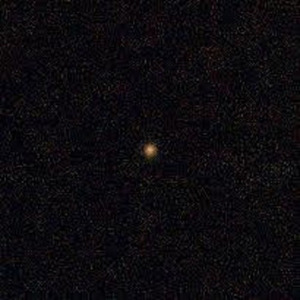
 )
)